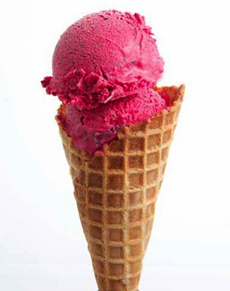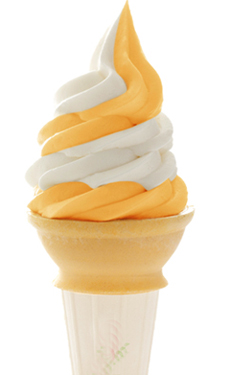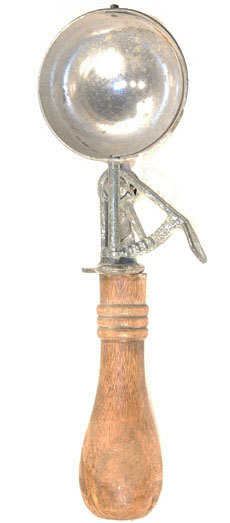
 The most convenient way to eat ice cream is in an edible cone. The invention of the cone is up for debate. Photo courtesy Talenti Gelato. The most convenient way to eat ice cream is in an edible cone. The invention of the cone is up for debate. Photo courtesy Talenti Gelato.
July 2006
Last Updated April 2013
|
 |
Ice Cream Cone History
Page 5: The Invention Of The Ice Cream Cone
This is Page 5 of an eight-page article on the history of ice cream and the ice cream cone. Click on the black links below to visit other pages.
1896: The Invention Of The Ice Cream Cone? Not Really!
- The first American cone: New York City. According to the IDFA, the first ice cream cone was produced in New York City in 1896 by Italo Marchiony, an Italian immigrant who was granted a patent in December 1903 for “small pastry cups with sloping sides.” The bottoms were flat, not conical, much like today’s molded cones. This is the first cone known to be produced in the United States; however, as we’ll see, a cone was invented far earlier in Paris.
- The second American cone: the 1904 World’s Fair in St. Louis. An independent creation was accidentally born at the 1904 World’s Fair in St. Louis (also known as the Louisiana Purchase Exposition). But three different vendors were vying for the credit. Ernest A. Hamwi, a Syrian concessionaire, was selling a crisp, waffle-like pastry called zalabia*; as were other concessionaires. Hamwi is generally credited with the invention of the cone. As at any large exposition, there were many vendors of ice cream and waffles; it is reported that approximately 50 ice cream stands dotted the Fair. In a letter he wrote in 1928 to the Ice Cream Trade Journal, he reported that it was either Arnold Fornachou or Charles Menches who ran the ice cream booth next to him. During the day, the ice cream vendor ran out of clean glass dishes.
- Hamwi rolled one of his wafer-like waffles into the shape of a cornucopia; the fresh-made “cone” cooled in a few seconds and the ice cream vendor was able to put a scoop of ice cream in it. The ice cream cones—known as cornucopias—became a hit of the Exposition. Enterprising locals quickly capitalized on the invention, creating special baking equipment to make cones to supply the crowds. Hamwi himself went on to found the Cornucopia Waffle Company; in 1910, he founded the Missouri Cone Company, later known as the Western Cone Company.
*Zalabia are not like Belgian or American waffles; they are flat and most resemble Italian pizzelle, including the grid pattern on the surface. |
|

The waffle cone, the “original” ice cream cone. Photo courtesy Vermont Creamery.

A sugar cone. Photo courtesy Pinkberry.
|
- Another vendor claims the idea. Abe Doumar, a Syrian immigrant who sold souvenirs at the Exposition, later claimed that he had invented the cornucopia. Although he was not selling zalabia, he said that in Syria, it was his custom to roll up meat and falafel in round flatbreads, as a cone-shaped sandwich. He said that he freely shared the idea with the zalabia vendors to create a kind of Syrian ice cream sandwich and the idea spread from stand to stand, including Hamwi’s. After the exposition, he moved to New Jersey, developed a four-iron zalabia machine and opened ice cream stands. But Nick Kabbaz, president of the St. Louis Ice Cream Cone Company, said that he worked for Hamwi at the time and that the idea for the cone was Hamwi’s.
- But it was really invented in Paris. Or Italy. While the ice cream cone was popularized in America, it was not invented here. Robin J. Weir, co-author of the book, Frozen Desserts, has spent years researching this topic and purchased a print dated 1807 of a young woman eating an ice cream cone at the Gardens Of Frascati, a Parisian café, restaurant and gaming house known for its ices. You can read the full story and see the print. Was it edible or glass? An 1820 print of an ice cream seller in Naples shows glass cones on his cart.
- And it took another century for edible cones to take hold. For whatever reason, the ice cream cone served by M. Garchi, the proprietor of Frascati, did not spread through Europe or cross the pond. Garchi died broke in 1809, two years after the print was made. It took another century for the two distinct types of cones we know today to emerge commercially. The rolled cone (today called a “sugar cone”) was a waffle, baked in a round shape on a griddle and rolled, originally by hand, later mechanically. It hardened a few seconds after it came off the griddle. The second type of cone was molded, like the example in the photo above.
|
|

An old-fashioned ice cream scoop. Photo by Brandon Heyer | SXC.
|
- And its success required the invention of the ice cream scoop. Serving ice cream cones would have been a relatively cumbersome undertaking had the ice cream scoop not been invented by William Clewell of Reading, Pennsylvania, in 1878. The first scoop was conical-shaped. More than 240 scoop designs were patented in the next 60 years, in all shapes and sizes. Imagine using a spoon or a spatula to pack an ice cream cone!
Continue To Page 6: The Invention Of Frozen Custard
Go To The Article Index Above
Lifestyle Direct, Inc. All rights reserved. Images are the copyright of their respective owners.

|




 The most convenient way to eat ice cream is in an edible cone. The invention of the cone is up for debate. Photo courtesy Talenti Gelato.
The most convenient way to eat ice cream is in an edible cone. The invention of the cone is up for debate. Photo courtesy Talenti Gelato.

